August 4th, 1895 — July 1st, 1976
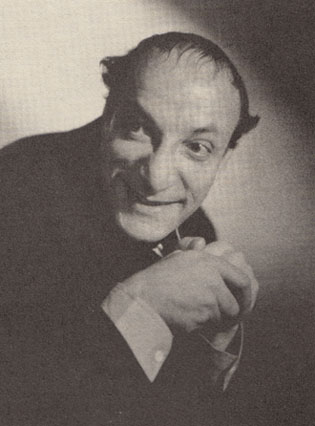
Above: A publicity portrait of John Picorri from the serial Dick Tracy (Republic, 1937).
John Picorri only appeared in a handful of serials during the course of a brief screen career, but is (deservedly) very well-remembered by devotees of the chapterplay genre. He specialized in flamboyant but subtle portrayals of secondary villains, characters who were neither ambitious masterminds nor active henchmen–but who were usually just as frightening as the more prominent heavies that they served, thanks to Picorri’s great talent for convincingly conveying malignity, craftiness, and outright insanity.
John Picorri was born Jacob Weinstein in London, England. He came to America in 1915, and at first settled in Cleveland, Ohio, becoming an American citizen in 1921. In 1920 he was living in Ohio and working for an automobile company (presumably as a salesman), but by 1922 he was working as a musician in New York, as shown by a radio station program entry from that year. He was using Picorri as a nom de theatre by 1923, as shown by his copyright registrations in that year for a musical number and a “dramatic composition” (legal language for some kind of play or theatrical sketch); although he registered the copyrights in his own name, he identified “John Picorri” as the author of the works. Based on these copyrights, a 1925 New York census entry giving his occupation as “actor,” the Internet Broadway Database’s crediting of Picorri in a 1927 play, and his 1932 marriage certificate (which lists his occupation as “director”), it appears that he spent his early theatrical years on the New York stage, working both as an actor and in various behind-the-scenes capacities. He first turned up in Hollywood around 1935, and spent the next seven years working there as a minor character player in A and B features; his darkish complexion, prominent nose, and noticeable but unobtrusive British accent gave him an indeterminately foreign aura that won him many bit parts as continental Europeans, Mexicans, and even occasional Middle Easterners.
Picorri’s first serial role was of a similarly exotic cast; Robinson Crusoe of Clipper Island (Republic, 1936) featured him as a Polynesian named Porotu, the sinister high priest of Pele the Fire Goddess. His sly and scheming character aspired to become ruler of the island of Komatoa by ousting the isle’s rightful monarch, Princess Melani (Mamo Clark)–and received backing from a ruthless spy ring headquartered on neighboring Clipper Island; in exchange for this support, Porotu repeatedly tried to incite the natives to do away with the spy ring’s chief opponent, a US government agent (Ray Mala). Porotu and the subplot surrounding him were often pushed into the background by the central spy-ring plot, but Picorri still received many scenes in Clipper Island and carried them off in fine style–making his auxiliary heavy a good deal more interesting than the spies’ seldom-seen mystery leader. Despite looking nothing like a Pacific islander, he came off as assured and dignified instead of ill-at-ease in his high-priest getup, and delivered lines like “Pele is quick to destroy those who arouse the wrath of the gods” with imposing grimness. Picorri was also called upon to display hypocritical obsequiousness (when pretending to bow to Melani’s orders), cold anger (when plotting against the princess), cruel and arrogant exultation (when he was on the verge of eliminating Melani and seizing control of Komatoa), and guilty dread (when he was forced to prove his right to kingship in an ancient trial-by-ordeal ceremony); he handled these varying aspects of Porotu’s villainy with polished flair.
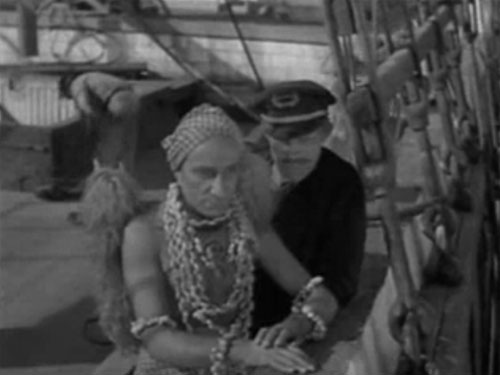
Above: John Picorri plots with Bob Kortman in Robinson Crusoe of Clipper Island (Republic, 1936).
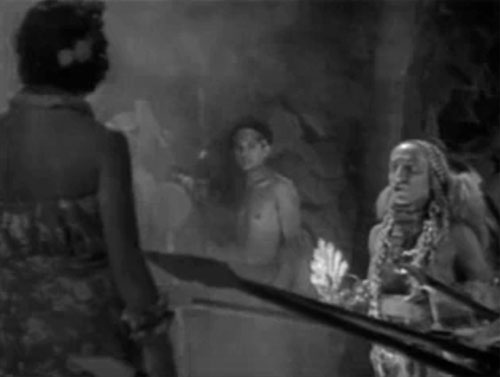
Above: “As you leap into the fire pit, Princess Melani, remember the vengeance of a priest of Pele.” John Picorri, holding the crown of the Komatoan kings, gloats triumphantly as he prepares to sacrifice Mamo Clark (back to camera) in Robinson Crusoe of Clipper Island.
Picorri followed his Robinson Crusoe of Clipper Island turn with his most famous chapterplay characterization—the hunchbacked brain surgeon Moloch in the 1937 Republic serial Dick Tracy. This ominously-named medical man was the scientific aide to a master criminal called the “Lame One;” to further said criminal’s ends, he performed an operation that changed G-man Dick Tracy’s brother Gordon into an amnesiac killer, and unctuously gloated over the success of his evil experiment throughout the remainder of the serial—when not expressing his hope for a chance to perform the same operation on Dick Tracy himself; he came scarily close to achieving this horrible goal in the serial’s suspenseful climactic sequence. Aside from his surgical activities, Moloch did little in Dick Tracy but discuss strategies with the Lame One—but he emerged as one of the creepiest and most unsettling characters in Republic’s entire serial canon, thanks in large part to Picorri’s performance. His gleefully ghoulish smiles and leers made him seem completely deranged, but his crisp, confident, and precisely-enunciated delivery of his lines also made him seem dangerously shrewd and intelligent; the pieces of sound villainous advice he periodically offered to the Lame One sounded just as convincing as his mad-scientist ponderings–like his academic speculation on the possibilities of transferring a cat’s brain into a human skull. Speaking of cats, Moloch spent almost all of Dick Tracy affectionately stroking a small black feline, an eerily incongruous bit of business that enhanced the character’s menacing aura and helped Picorri steal many scenes (not that he needed too much help in that department).

Above: Moloch (John Picorri), his cat, and the mysterious Lame One in Dick Tracy (Republic, 1937).

Above: Gordon Tracy (Carleton Young) and the Lame One watch as John Picorri’s Moloch and a pair of assistants prepare to operate on Dick Tracy (Ralph Byrd).
SOS Coast Guard (Republic, 1937), gave Picorri his least sinister serial-villain role; he played a shifty chemist named G. A. Rackerby, who was reluctantly forced to assist munitions smuggler Boroff (Bela Lugosi) in the manufacture of a deadly dissolving gas. Picorri spent most of Coast Guard in the background, but did an excellent job of registering half-repressed fear of both Lugosi’s character and the authorities (particularly coastguardsman hero Ralph Byrd); his articulate and believable-sounding explanations of the dissolving gas’s chemical properties were also very effective, as was his terror-stricken expression when his scientific colleague and business partner was murdered off-screen by henchman Richard Alexander, after refusing to abet Lugosi’s schemes.
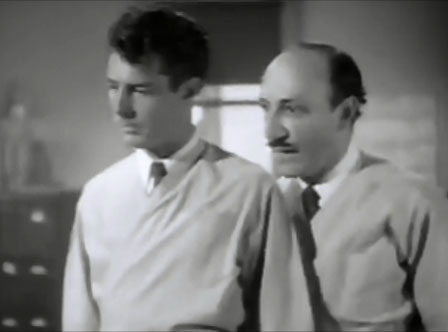
Above: Chemist partners Jack Roberts and John Picorri receive an offer-they-can’t-refuse from the off-camera Bela Lugosi in SOS Coast Guard (Republic, 1937).
Picorri played his last major chapterplay part in The Fighting Devil Dogs (Republic, 1938). As in Dick Tracy, he was cast as a hunchbacked and certifiably mad scientist, and functioned as an aide-de-camp to a master criminal (the would-be world conqueror known as the Lightning). Picorri’s Devil Dogs character (Professor Gould) had less dialogue and less to do than his Moloch in Tracy, but Picorri still made a strong and scary mark on the serial. He scuttled about the Lightning’s airborne “flying wing” headquarters like a spider, presided with feverish glee over the dropping of firebombs or the launching of electrical missiles, and generally gave the Professor a demeanor even more unbalanced than that of Moloch—particularly when he was grinning worshipfully as the Lightning ranted about ruling the world, or when he was expressing his delight over the Lightning’s lethal electrical depredations (“Your calculations were perfect, master; they’re all dead, and there’s no sign of how you killed them!”).
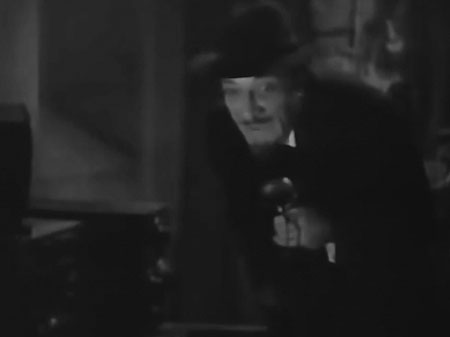
Above: John Picorri radios a report to the Lightning in The Fighting Devil Dogs (Republic, 1938).

Above: The Lightning and John Picorri menace Eleanor Stewart in The Fighting Devil Dogs.
Picorri made one final serial appearance in Drums of Fu Manchu (Republic, 1940); he had a one-chapter bit as Dr. Kranz, a crooked “plastic artist” who made a life-mask of kidnapped hero Robert Kellard that allowed Fu Manchu (Henry Brandon) to escape a police dragnet. Picorri had only a few minutes of screen time here, but played his part with amusing quirkiness—performing his shady and rather peculiar task with calmly scientific detachment, and treating the dreaded Fu Manchu with the same politely professional manner that a dentist might adopt towards a patient.
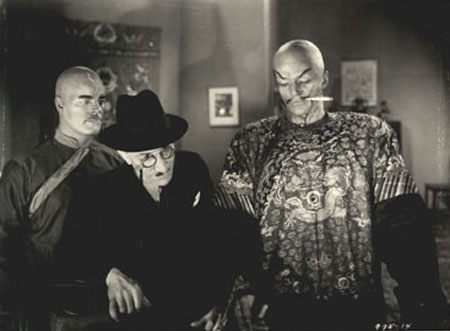
Above: John Merton, John Picorri, and Henry Brandon in Drums of Fu Manchu (Republic, 1940).
Picorri’s screen career came to an end not long after Fu Manchu’s release; his last film seems to have been the 1942 MGM historical short Madero of Mexico. His 1942 draft-registration form indicates that he left movie work to return to the musical work that he had engaged in during the 1920s. On the draft registration, Picorri lists his employer as Ivor Kallin of the “Kallin Co.” A check of the 1940 census reveals this Kallin to be an English-born musician, living in the same Los Angeles district as Picorri and working in the “radio station” industry; one would assume that the Kallin Co. was a company or corporation involved in providing music for radio broadcasts. Based on Picorri’s 1923 copyrights and the 1922 radio station entry, it seems reasonable to conjecture that Picorri by 1942 was working for Kallin as a musician and/or composer. The only other hard fact available concerning John Picorri is the date of his decease, acquired from the Social Security death index; he was still residing in Los Angeles at the time of his passing.
John Picorri’s four 1930s serials provide the only extended screen showcases for a unique character actor who deserved far more screen exposure than he received; other serial players could have portrayed Picorri’s scheming Porotu or his furtive Rackerby with comparable skill, but none of them could have handled demonic madmen like Moloch or Professor Gould as memorably or effectively as he did. Like the far better-known Dwight Frye, Picorri had the ability to go completely “over the top” without coming off as merely hammy; outrageously demented though his best-known serial characters were, he played them so intensely and so skillfully that they actually seemed believable—and thus all the more nightmarish.
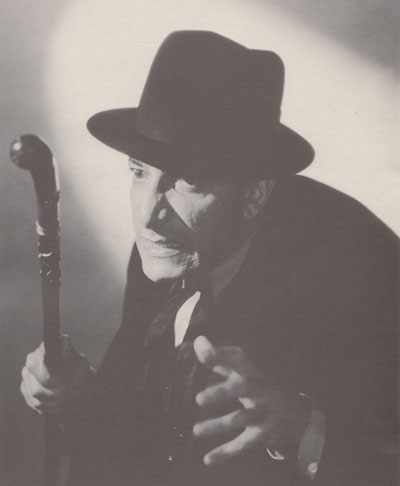
Above: John Picorri in another publicity still from Dick Tracy.
Acknowledgements: My thanks to James Swan (see the comments below) for retrieving Picorri’s copyright records, his marriage certificate, and other documents which established his real name, fleshed out the picture of his pre-Hollywood career a little more, and provided the date of his arrival in America.
Thanks for all the great research and info on these actors. I’m enjoying finding out so much about them. On TV in the fifties comics would do take-offs on horror films and the mad scientist always had a bent over, hand-rubbing, “yes, master” depraved lackey. It was not until recent years when in retirement I had time to pursue an interest in serials that I found out these grotesque underlings were based on Picorri more than anyone else. Although his name is not well known, his image endured in popular culture.
Great article on one of my favorite character actors. I especially enjoyed the biographical details, and they prompted me to look into some of the documents available online to see what else might be discovered.
The Library of Congress copyright catalog for 1923 shows two entries for John Picorri – one a dramatic composition and the other a musical number. Picorri is listed as the author of the compositions and the copyright proprietor is identified as Jacob Weinstein.
A Eunice Berlin was married on 18 September 1932 in Cleveland, Ohio to one Jacob Weinstein. He is identified as being age 37, born in England and at the time residing in New York City. His occupation is listed as “director”. The 1940 US Census shows John Picorri, his wife Eunice and a woman identified as a sister, Evelyn Berlin, living at the same residence in Los Angeles. From this and other FamilySearch records, it seems reasonably certain that Picorri’s wife was the same Eunice Berlin that married Weinstein in 1932.
Which raises two interesting questions – were Jacob Weinstein and John Picorri the same person? Was Picorri a stage name used by Weinstein? I haven’t traced Weinstein further as yet, but it might be an interesting subject for additional research.
Update: I found another link between Weinstein and Picorri. An obituary was published in the Cleveland Plain Dealer dated 17 December 1938 for Mrs. Elizabeth Weinstein (nee Trenner). She was the mother of Jacob Weinstein, and in the article the surviving children mentioned include a son, John, of Los Angeles. She had no other sons by that name so I think that it’s a safe bet that it’s Picorri. Perhaps he legally changed his name sometime after the marriage in 1932. He was using the Picorri surname for his 1942 draft registration, so I presume it was then his legal name.
Update 2: In the same edition of the Plain Dealer, there is an separate article about Mrs. Weinstein’s death and it specifically mentions one of her sons as being “John Picorri, Hollywood screen actor.”
Thanks, Jim. That’s great information, and I have incorporated it into the article. The only thing that puzzles me is when Picorri/Weinstein legally changed his name, if in fact he ever did–since he’s listed as John Picorri on the New York state census, but used the Weinstein name seven years later on his marriage certificate. In any case, thanks again for helping me improve a biography.
By the way, if you have the time (I just don’t have much any more), I’d be interested to see if you could dig up anything on James Craven, who’s the only one of the serial players featured here that I haven’t been able to find an accurate birth and death date for (the IMDB is completely wrong on him).
I’m glad to hear that the information is proving useful. Here’s a few more items to add to the Weinstein / Picorri narrative.
He appears on the 1911 England / Wales census (along with his family) as Jack Weinstein. He emigrates to the United States in June 1915, arriving in New York and then moving with his parents to Cleveland, Ohio. He begins the naturalization process in December 1917 and becomes a naturalized citizen in June 1921. The 1911 census and the 1915 arrival information definitely contradict the later 1925 New York state census length-of-residency information.
He is listed on the 1920 US census (again as Jack). He is residing with his parents and indicates that he is employed by the Peerless Motor Car company. Sometime after 1921, he relocates to the East Coast. A New York radio station program entry in a DC newspaper dated August 1922 lists (among others) musical performances by John Picorri. As to when (or if) he ever legally changed his name, I suppose that’s a question that may never be answered.
Regarding the elusive James Craven, researching his life sounds very intriguing. I’ll take a run at it, and let you know what I find.
Thanks again; I’ve updated the piece again with that information.
Hi, John Piccori was my grandfather’s uncle. I know nothing about him except a family story he had a parrot with it’s own room. I didn’t even know he was an actor until relatively recently. (I know this is all unprovable info.)
What might be helpful though, is that some of the family at least anglicized Weinstein to Winston.
This is really interesting information. Thanks for doing all this research.
Kamala, here’s a Weinstein family tree, including John Piccori’s parents, John, and Eunice.
https://www.ics.uci.edu/~dan/genealogy/Krakow/Families/Weinstein.html
My grandfather, Monte Winston (born Weinstein), was Sir John’s first cousin. My aunt, Helene Winston, was an actress who moved from Canada to Los Angeles in the early 1960s. She was quite friendly with Eunice and John and was the one who told me that he had “knighted” himself!
Here is a film from 1935, ‘False Pretenses’ in which John Piccori is listed further down the cast, so it seems safe to assume that his role will be smaller in size…but possibly unforgettable. Plus, it’s a comedy! So at 1935, this is before his evil-brain-surgeon manifestations.
_____________
_____________
A follow up: This is a fun comedy, but John Picorri’s part is simply a small role, with just a few lines.
Still it’s nice to see…
Regarding his life after leaving the film and serial industry, a small mention in the February 9, 1953 Hollywood Reporter has him in the LA area directing a play: “Adele Comandini and John Picorri have been added to the teaching staff of Chapman College’s drama and music workshop.” A few weeks later, the Reporter provided more detail when it announced: “Adele Comandini’s “Pardon My Ph.D” opens at Chapman College tonight as the first project of the new Music and Drama Workshop supervised by members of the film industry … John Picorri is director.” (The job was probably short-lived; the following year, Chapman College moved from Los Angeles to Orange County). There’s also a mention in a1967 edition of the LA Times calendar of events that reads: “WESTWOOD – Sir John Picorri will present a one-act play, The Children, at the Westwood Temple sisterhood luncheon, Tuesday, Feb 28 at noon, at 10505 Santa Monica Blvd.” If it’s the same John Picorri, it never ceases to amaze me how many actors left film and serial work for everyday jobs back in the day.
Greg – I just noticed your post regarding John Picorri. My own research on him had pretty much dead-ended, with the last information being dated early 1940’s, so it was great to read some items detailing a few of his later activities. Thanks for the interesting information.
John Picorri was my uncle. His wife Eunice was my mothers sister. That was his stage name but became his legal name. Yes he is as part of the Weinstein family. We had a close relationship with him and my Aunt Eunice. She was one of my mothers Five sisters. I remember having Seders at their house every year along with the Weinstein family. He had many occupations after leaving the theater. His final job was restoring art and paintings. He worked for many famous people